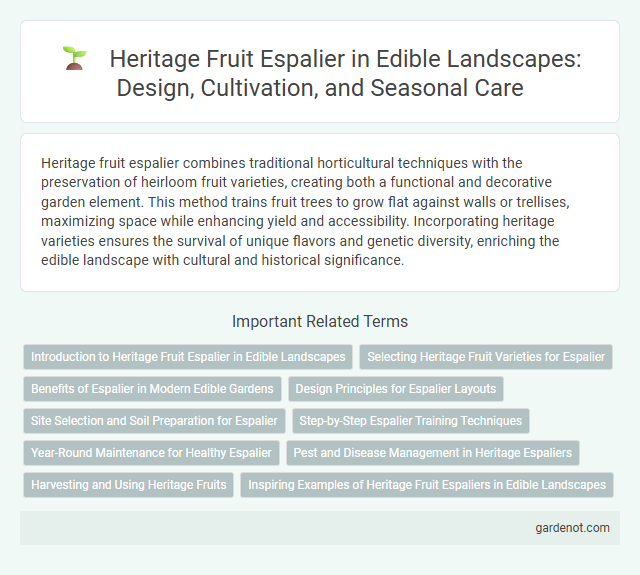Heritage fruit espalier combines traditional horticultural techniques with the preservation of heirloom fruit varieties, creating both a functional and decorative garden element. This method trains fruit trees to grow flat against walls or trellises, maximizing space while enhancing yield and accessibility. Incorporating heritage varieties ensures the survival of unique flavors and genetic diversity, enriching the edible landscape with cultural and historical significance.
Introduction to Heritage Fruit Espalier in Edible Landscapes
Heritage fruit espalier integrates traditional pruning techniques with historic fruit tree varieties to create visually appealing and space-efficient edible landscapes. This method enhances biodiversity, preserves genetic heritage, and maximizes fruit production on vertical structures like walls or fences. Using heirloom apples, pears, and plums, heritage fruit espaliers provide a sustainable and ornamental addition to gardens while promoting seasonal harvesting.
Selecting Heritage Fruit Varieties for Espalier
Choosing heritage fruit varieties for espalier involves prioritizing cultivars with proven disease resistance, adaptability to local climates, and historical significance. Varieties like 'Golden Delicious,' 'Gravenstein,' and 'Baldwin' apples, or 'Ne Plus Ultra' pears, provide strong flavor profiles and reliable yields while enhancing biodiversity. Integrating these heritage fruits into espalier training maximizes space efficiency and preserves genetic diversity in sustainable edible landscapes.
Benefits of Espalier in Modern Edible Gardens
Heritage fruit espalier maximizes space efficiency by training fruit trees flat against walls or fences, making it ideal for small urban gardens. This technique improves air circulation and sunlight exposure, enhancing fruit quality and reducing disease risk. Integrating espaliered trees in modern edible landscapes combines traditional aesthetics with sustainable food production, fostering biodiversity and easy harvesting.
Design Principles for Espalier Layouts
Heritage fruit espalier design prioritizes symmetry and balance by aligning branches along a central support, maximizing sun exposure and air circulation for optimal fruit production. Strategic spacing between tiers ensures adequate growth and reduces disease risk while maintaining aesthetic appeal. Incorporating traditional espalier forms like horizontal cordons or fan shapes emphasizes both functional yield and historic garden beauty.
Site Selection and Soil Preparation for Espalier
Selecting a sunny site with well-drained soil is crucial for the successful growth of heritage fruit espaliers. Soil preparation involves testing pH levels to maintain a slightly acidic to neutral range (6.0-7.0), enriching the soil with organic matter, and ensuring proper drainage to prevent root rot. Proper site selection and soil conditioning promote healthy root development and maximize fruit yield in edible landscapes.
Step-by-Step Espalier Training Techniques
Heritage fruit espalier thrives through precise step-by-step training techniques that include selecting healthy rootstock and pruning young shoots to establish a strong scaffold. Regular tying and directional pruning encourage horizontal branch growth, maximizing sun exposure and fruit production along walls or fences. Consistent maintenance during dormant and growing seasons ensures the espalier maintains its shape and supports heritage fruit varieties effectively.
Year-Round Maintenance for Healthy Espalier
Year-round maintenance of heritage fruit espalier involves regular pruning to promote air circulation and sunlight exposure, essential for healthy growth and fruit production. Consistent monitoring for pests and diseases ensures early intervention, preserving the plant's vitality and heritage traits. Seasonal fertilization with organic matter supports nutrient balance, enhancing fruit quality and longevity of the espalier structure.
Pest and Disease Management in Heritage Espaliers
Heritage fruit espaliers require targeted pest and disease management to preserve their historical varieties and maintain plant health. Integrated pest management (IPM) practices, including regular monitoring, organic sprays, and beneficial insect introduction, effectively control common threats like aphids, codling moths, and apple scab. Proper pruning and ensuring good air circulation reduce fungal infections, enhancing the longevity and productivity of heritage fruit espaliers.
Harvesting and Using Heritage Fruits
Harvesting heritage fruit espaliers requires careful timing to preserve peak flavor and nutritional value, often occurring in late summer to early autumn depending on the variety. These fruits, prized for their unique heritage flavors and rich antioxidant content, can be used fresh, in preserves, or incorporated into seasonal recipes that celebrate their distinct taste profiles. Proper pruning and maintenance throughout the year ensure consistent fruit production and high-quality harvests from heritage espaliered trees.
Inspiring Examples of Heritage Fruit Espaliers in Edible Landscapes
Heritage fruit espaliers transform edible landscapes by combining historical fruit varieties with artistic pruning techniques, maximizing space and yield. Notable examples include espaliered Heritage apples in traditional English gardens and vintage pear varieties trained along brick walls in French chateaux, showcasing both aesthetic appeal and rich genetic diversity. These living walls provide functional beauty, improve microclimates, and preserve heirloom fruit genetics within sustainable urban and rural settings.
Heritage fruit espalier Infographic

 gardenot.com
gardenot.com